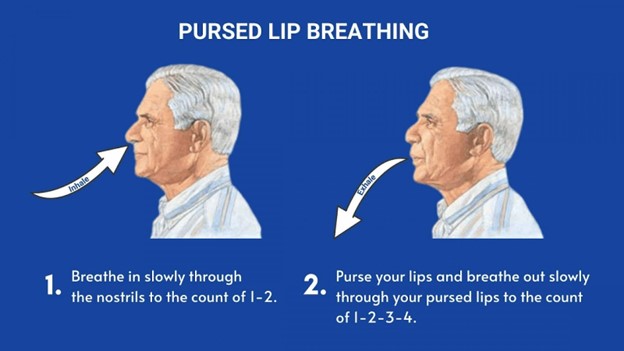A nurse is teaching pursed-lip breathing to a client who has COPD. Which of the following instructions should the nurse include in the teaching?
"Lie down while practicing pursed-lip breathing.".
"Exhale slowly through your mouth.".
"Inhale through pursed lips.".
"Puff your cheeks when exhaling.".
The Correct Answer is B
Choice A rationale:
Lying down while practicing pursed-lip breathing is not the correct instruction. Pursed-lip breathing is usually performed in a sitting or standing position. Lying down can restrict lung expansion and may not effectively support the purpose of this breathing technique, which is to improve airway pressure and reduce air trapping.
Choice B rationale:
"Exhale slowly through your mouth" is the correct instruction for pursed-lip breathing. This technique involves inhaling through the nose for a count of two and exhaling slowly and steadily through pursed lips for a count of four. The goal is to promote better exhalation, prevent airway collapse, and improve oxygen exchange. The rationale behind this choice is grounded in the mechanics of pursed-lip breathing, which helps create backpressure in the airways, maintaining them open and aiding in proper exhalation.

Choice C rationale:
Inhaling through pursed lips contradicts the proper sequence of pursed-lip breathing. The technique involves inhaling through the nose and exhaling through pursed lips. Inhaling through pursed lips would not provide the intended benefits of the technique.
Choice D rationale:
"Puff your cheeks when exhaling" is not the correct instruction. Puffing the cheeks during exhalation does not contribute to the effectiveness of pursed-lip breathing. This action could potentially impede proper exhalation and defeat the purpose of the technique, which is to control airflow and improve breathing efficiency.
Nursing Test Bank
Naxlex Comprehensive Predictor Exams
Related Questions
Correct Answer is C
Explanation
Choice A rationale:
Peer pressure (Choice A) is an external stressor, as it involves the influence of others on an individual's thoughts or actions. It originates from outside the individual and is not directly related to an internal psychological response.
Choice B rationale:
Death of a family member (Choice B) is an external stressor, as it is an event that occurs externally to the individual. While it can cause significant emotional distress, it is not considered an internal stressor.
Choice C rationale:
Fear of medical test results (Choice C) is the correct answer as an internal stressor. Internal stressors are psychological or emotional factors that originate within the individual and contribute to stress. Fear of medical test results is a personal worry that can lead to anxiety and emotional turmoil.
Choice D rationale:
Job transfer to another city (Choice D) is an external stressor, as it involves a change in the individual's external environment. It is not an internal psychological factor causing stress.
Correct Answer is B
Explanation
Choice A rationale:
Inquiring whether the client's family knows about their anxiety is not directly related to addressing the client's current anxiety. The focus should be on the client's feelings and needs rather than involving the family in this particular instance.
Choice B rationale:
This choice is the most appropriate response. Asking the client to share memories from their past redirects their attention from the current anxiety-provoking situation. Discussing positive memories can help alleviate anxiety and provide comfort to the client.
Choice C rationale:
Suggesting to talk later after caring for other clients dismisses the client's immediate need for support and comfort. It's essential to address the client's anxiety promptly rather than delaying the discussion.
Choice D rationale:
Asking the client why they are feeling anxious might put them on the spot and could potentially escalate their anxiety. Instead of prompting them to explain the cause of their anxiety, the nurse should focus on providing reassurance and distraction.
Whether you are a student looking to ace your exams or a practicing nurse seeking to enhance your expertise , our nursing education contents will empower you with the confidence and competence to make a difference in the lives of patients and become a respected leader in the healthcare field.
Visit Naxlex, invest in your future and unlock endless possibilities with our unparalleled nursing education contents today
Report Wrong Answer on the Current Question
Do you disagree with the answer? If yes, what is your expected answer? Explain.
Kindly be descriptive with the issue you are facing.
